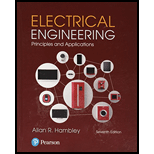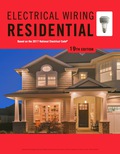
Electrical Engineering: Principles & Applications (7th Edition)
7th Edition
ISBN: 9780134484143
Author: Allan R. Hambley
Publisher: PEARSON
expand_more
expand_more
format_list_bulleted
Textbook Question
Chapter 9, Problem 9.5P
Compute the values of
Expert Solution & Answer
Want to see the full answer?
Check out a sample textbook solution
Students have asked these similar questions
Q1: For the circuits shown in figures. If the temperature has changed from 25°C to 65°C. find
AIc. Ic=1.5mA at 25°C.
Vcc
+20v
25°C
65°C
47k
33.9k
55
70
Ico
InA
16nA
12knS
VBE 0.6
0.5
S1.2k
Two heating elements which is 500 ohms and 250 ohms are connected in series with temperature coefficients of 0.001 and 0.003 ohms per °C, respectively at 20°C and heated at 50°C, Calculate the effective temperature coefficient of the combination at 20°C
8. Liquids with solid impurities
a) Have higher dielectric strength
b) Of large size have higher dielectric strength
c) Have lower dielectric strength as compared to pure liquids
d) None of the above
9. Peak to peak ripple is defined as
a) the difference between average de voltage and peak value
b) the difference between maximum and minimum de voltage
c) the difference between maximum ac and average de voltages
d) the difference between ac (rms) and average de voltages
10. In a Cockroft-Walton circuit, input voltage 100 kV load current 25 mA, supply
frequency 100 Hz, each capacitor 10 nF. The optimum no. of stages for maximum
output voltage is
a) 1
b) 2
c) 10
d) 35
Chapter 9 Solutions
Electrical Engineering: Principles & Applications (7th Edition)
Knowledge Booster
Learn more about
Need a deep-dive on the concept behind this application? Look no further. Learn more about this topic, electrical-engineering and related others by exploring similar questions and additional content below.Similar questions
- A coil has a resistance of 18 when it mean temp is from 20o C to 50o C. Find its mean temp rise when its resistance is 21 and the surrounding temp is 15o C. A potential difference of 250 V is applied to a copper field coil at a temp of 15o C and the current is 5A. What will be the mean temp of the coil when the current has fallen to 3.91 A, the applied voltage being the same as before.arrow_forwardA copper-oxide rectifier and a non-inductive resistance of 20 Ω are connected in series across a sinusoidal a.c. supply of 230 V (r.m.s.). The resistance of the rectifier is 2.5 Ω in forward direction and 3,000 Ω in the reverse direction. Calculate the r.m.s. and average values of the current. Answer: [r.m.s. value = 5.1 A, average value = 3.22 A]arrow_forwardAC xuf lac V ac 21. The simple AC powered circuit above is being measured for AC current and voltage across a 1uF capacitor. The measured current is 200mA and the measured voltage is 40V. (note: 2 separate questions follow) a. Calculate the capacitive reactance, Xc. b. Calculate the voltage frequency.arrow_forward
- 7. In a pure inductive circuit, the phase angle between the voltage waveform and current waveform will havephase shift * 180 deg O deg 45 deg O 90 deg 8. Why do we say the "voltage across" or "the voltage with respect to?" Why can't we just say voltage? * Voltage is a measure of electric potential difference between two electrical points. O It's an electrical cliche. The other point could be negative or positive. None of the above.arrow_forwardA capacitor of 1µF is charged to 100 volts and then disconnected from the power supply. A second but uncharged capacitor of 3µF is then connected across the first capacitor. What is the voltage across the parallel combination? O a. 110 volts O b. 45 volts O c. 66 volts O d. 25 voltsarrow_forwardA five-Ohm resistor is in series with a 0.001-Henry inductor and is supplied from a 10-V DC source. Solve for the current 2 milliseconds after the switch was turned on. a. 2.0000 Amperes b.1.9999 Amperes c.1.0001 Amperes d. 2.0001 Amperesarrow_forward
- In Figure, a 20 resistor is connected to a battery. Figure shows the increase of thermal energy Eth in the resistor as a function of time t. The vertical scale is set by Eths =2.50 mJ, and the horizontal scale is set by ts = 4.0 s. What is the electric potential across the battery? 0.20 V 0.15 V 0.30 V 0.10 V 0.25 V R Eh,s Eth (mJ) t (s) tsarrow_forwarda. individal current b. voltage sourcearrow_forwardQ2) Consider the circuit in Figure (3), and answer 3 branch only. a) What type of circuit is this? b) What is the total peak secondary voltage? c) Find the peak voltage across each half of the secondary. d) Sketch the voltage waveform across RL. 4:1 120 V rms RL 1.0 k2 D2 eeleearrow_forward
- Clear solutions pls. Thank you Given the following Resistances and Capacitors in Series and Voltage Source: R1 = 1 ohms R2 = 10 ohms C1 = 0.007 Farad C2 = 0.008 Farad Vs = 9 Volts Frequency = 6 Hz What is the Total Reactance in ohms?arrow_forwardPlease show complete solution 1 hour leftarrow_forwarda) What is the peak voltage across R2? b) What is the RMS value of I1?arrow_forward
arrow_back_ios
SEE MORE QUESTIONS
arrow_forward_ios
Recommended textbooks for you
 EBK ELECTRICAL WIRING RESIDENTIALElectrical EngineeringISBN:9781337516549Author:SimmonsPublisher:CENGAGE LEARNING - CONSIGNMENT
EBK ELECTRICAL WIRING RESIDENTIALElectrical EngineeringISBN:9781337516549Author:SimmonsPublisher:CENGAGE LEARNING - CONSIGNMENT

EBK ELECTRICAL WIRING RESIDENTIAL
Electrical Engineering
ISBN:9781337516549
Author:Simmons
Publisher:CENGAGE LEARNING - CONSIGNMENT
Diode Logic Gates - OR, NOR, AND, & NAND; Author: The Organic Chemistry Tutor;https://www.youtube.com/watch?v=9lqwSaIDm2g;License: Standard Youtube License